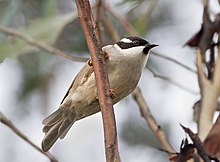Strong-billed honeyeater
| Strong-billed honeyeater | |
|---|---|

| |
| Scientific classification | |
| Domain: | Eukaryota |
| Kingdom: | Animalia |
| Phylum: | Chordata |
| Class: | Aves |
| Order: | Passeriformes |
| Family: | Meliphagidae |
| Genus: | Melithreptus |
| Species: | M. validirostris
|
| Binomial name | |
| Melithreptus validirostris (Gould, 1837)
| |
| Synonyms | |
|
Eidopsarus bicinctus Swainson | |
The strong-billed honeyeater (Melithreptus validirostris) is a species of
Taxonomy
The strong-billed honeyeater was first described by ornithologist
The next closest relative outside the genus is the much larger, but similarly marked,
Description
A mid-sized honeyeater at 16.5–17.5 cm (6.5–7 in) in length, it is olive-brown above and pale grey-brown below, with a black head, nape and throat, a pale blue to off-white patch over the eye, and a white crescent on the nape.[7] Juveniles have brownish crowns, lemon-tinged nape, and an orange base of bill.[8] Its call is a loud cheep cheep, or a churring.[7]
Ecology
The strong-billed honeyeater is found in mature forest with large trees, such as Eucalyptus regnans and E. delegatensis. Its diet is principally insects and various other invertebrates, which it hunts on tree trunks, supplemented by nectar and fallen fruit.[8] Although both species are widespread in Tasmania, the Strong-billed rarely overlaps in site and foraging with the black-headed honeyeater.[9]
Breeding
Strong-billed honeyeaters may nest from September to January, breeding once or twice during this time. The nest is a thick-walled bowl of grasses and bits of bark in the fork of a tall tree, usually a eucalypt. Two or three eggs are laid, 22 x 17 mm in size, and shiny, buff-pink, sparsely spotted with red-brown.[10]
References
- ^ BirdLife International (2022). "Melithreptus validirostris". IUCN Red List of Threatened Species. 2022: e.T22704148A211167683. Retrieved 24 July 2022.
- ^ Gould, John (1837). A Synopsis of the Birds of Australia, and Adjacent Islands. London.
- ISBN 0-304-52257-0.
- S2CID 25346288.
- ^ Driskell, A.C., Christidis, L (2004) Phylogeny and evolution of the Australo-Papuan honeyeaters (Passeriformes, Meliphagidae) Molecular Phylogenetics and Evolution 31 943–960
- ^ Barker, F.K., Cibois, A., Schikler, P., Feinstein, J., and Cracraft, J (2004) Phylogeny and diversification of the largest avian radiation. Proceedings Natl. Acad. Sci., USA 101 11040-11045
- ^ ISBN 1-876334-60-6.
- ^ a b "Strong-billed Honeyeater". Birds in Backyards. Birds Australia. 17 May 2006. Retrieved 28 June 2010.
- .
- ISBN 0-646-42798-9.

